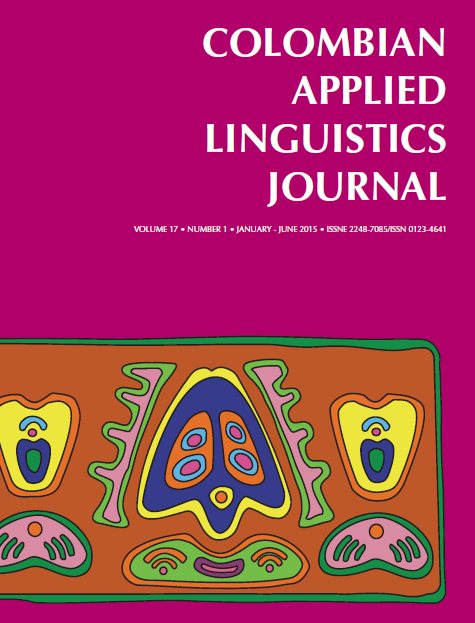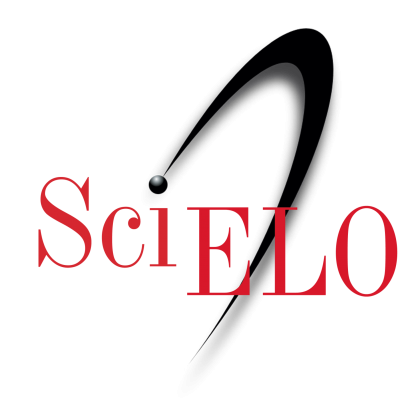DOI:
https://doi.org/10.14483/udistrital.jour.calj.2015.1.a01Published:
2015-01-21Issue:
Vol 17, No 1 (2015) January-JuneSection:
Research ArticlesTypology in the classroom: fostering motion-event awareness in spanish-speaking ELLs
Tipología en el aula de clase: la adopción de la conciencia del “motion-event” en aprendices del inglés de habla española
Keywords:
The Conceptual Approach, evidencias negativas, tipología lingüística, verbos de movimiento (es).Keywords:
The Conceptual Approach, linguistic typology, negative evidence, verbs of motion (en).Abstract (en)
The aim of the present paper is to address the implications of the direct instruction of the linguistic typology of verbs of motion in English second-language learners. Results of a small-scale research study are reported in which students were exposed to typology instruction with the goal of increasing proficiency and target-like production. To this end, it was hypothesized that pre- and post-intervention writing samples would differ significantly in the appropriate use of expressions of motion, particularly those expressions employing English manner-of-motion verbs. Results confirmed this hypothesis and demonstrated that students achieve greater proficiency in motion-event expression when exposed to explicit instruction including negative evidence and aspects of the Conceptual Approach (White, 2012).
Abstract (es)
El presente artículo revisa implicaciones relacionadas con la enseñanza directa de la tipología lingüística de verbos de movimiento en el proceso de aprendizaje del inglés como lengua extranjera. Se presentan resultados de un estudio a menor escala en el cual primó la enseñanza de esta tipología de manera directa con el fin de fomentar la competencia y la producción natural de las estructuras en mención. Para tal efecto, se planteó una hipótesis argumentando que las muestras de escritura indicarían un cambio significativo en cuanto al uso de las expresiones de movimiento en inglés, sobre todo en aquellas que emplean verbos que expresan manera de movimiento. Los resultados confirmaron esta hipótesis y demostraron que los estudiantes alcanzaron una producción más natural con la enseñanza directa que incluye evidencias negativas y ciertos aspectos del Conceptual Approach (White, 2012).
References
References
Aske, J. (1989). Path predicates in English and Spanish: A closer look. Proceedings of the Fifteenth Annual Meeting of the Berkeley Linguistics Society. Berkeley: Berkeley Linguistics Society, 1-14.
Cadierno, T., & Robinson, P. (2009). Language typology, task complexity and the development of L2 lexicalization patterns for describing motion events. Annual Review of Cognitive Linguistics, 7(1), 245-276.
Cadierno, T., & Ruiz, L. (2006). Motion events in Spanish L2 acquisition. Annual Review of Cognitive Linguistics, 4(1), 183-216.
Camacho, Juana. (2010). Classroom research on the teaching of phrasal verb combinations. Quaderns Digitals, 64. Retrieved from the Quaderns Digitals database.
Carroll, M., Murcia-Serra, J., & Watorek, M. (2000). The relevance of information organization to second language acquisition studies. Studies in Second Language Acquisition, 22(3), 441-466. doi:10.1017/S0272263100003065
Cifuentes-Férez, P., & Gentner, D. (2006). Naming motion events in English and Spanish. Cognitive Linguistics, 17(4), 443-462.
Council of Europe (2011). Common European Framework of Reference for: Learning, Teaching, Assessment. Council of Europe.
Davies, M. (2008). The Corpus of Contemporary American English: 450 million words, 1990-present. Available online at http://corpus.byu.edu/coca/.
Elliott, E., & Yountchi, L. (2009). Total physical response and Russian multi- and unidirectional verbs of motion: A case study in acquisition. Slavic & East European Journal, 53(3), 428-450.
Author. (2013). Linguistic typology and verb structure: A comparative approach for the EFL classroom. In W. Escobar (Ed.) Social research applied to English language teaching: Theory and methods (pp. 21-36). Bogotá: Editorial Universidad El Bosque.
Evans, V., & Green, M. (2006). Cognitive linguistics: An introduction. Edinburgh: Edinburgh University Press.
Filipović, L. (2008). Typology in action: Applying typological insights in the study of translation. International Journal of Applied Linguistics, 18(1), 23-40.
Filipović, L., & Vidaković, I. (2010). Typology in the L2 classroom: Second language acquisition from a typological perspective. In M. Pütz, L. Sicola (Eds.), Cognitive processing in second language acquisition: Inside the learner's mind (pp. 269-291). Amsterdam Netherlands: John Benjamins Publishing Company.
Gor, K., & Cook, S. (2010). Nonnative processing of verbal morphology: In search of regularity. Language Learning, 60(1), 88-126.
Gor, K., Cook, S., Malyushenkova, V., & Vdovina, T. (2009). Verbs of motion in highly proficient learners and heritage speakers of Russian. Slavic & East European Journal, 53(3), 386-408.
Hacohen, A. (2006). The psychological reality of the telic/atelic distinction: Evidence from adult and child Hebrew. Proceedings of the 21st Annual Meeting of the Israel Associations for Theoretical Linguistics, (unnumbered).
Hasko, V. (2009). The locus of difficulties in the acquisition of Russian verbs of motion by highly proficient learners. Slavic & East European Journal, 53(3), 360-385.
Ibarretxe-Antuñano, I. (2004). Language typologies in our language use: The case of Basque motion events in adult oral narratives. Cognitive Linguistics, 15(3), 317-349.
Ibarretxe-Antuñano, I. (2009). Path salience in motion events. In J. Guo, E. Lieven, N. Budwig, S. Ervin-Tripp, K. Nakamura, Ş. Õzçalişkan (Eds.), Crosslinguistic Approaches to the psychology of language: Research in the tradition of Dan Isaac Slobin (pp. 403-414). New York, NY US: Psychology Press.
Ibarretxe-Antuaño, I. (2012). Linguistic typology in motion events: Path and manner. In: Anuario del Seminario de Filología Vasca ‘Julio de Urquijo’. International Journal of Basque Linguistics and Philology.
Izumi, S., & Lakshmanan, U. (1998). Learnability, negative evidence and the L2 acquisition of the English passive. Second Language Research, 14(1), 62-101.
Ji, Y., Hendriks, H., & Hickmann, M. (2011). How children express caused motion events in Chinese and English: Universal and language-specific influences. Lingua, (12), 1796-1819. doi:10.1016/j.lingua.2011.07.001
Kersten, A. W., Meissner, C. A., Lechuga, J., Schwartz, B.
L., Albrechtsen, J. S., & Iglesias, A. (2010). English speakers attend more strongly than Spanish speakers to manner of motion when classifying novel objects and events. Journal of Experimental Psychology: General, 139(4), 638-653. doi:10.1037/a0020507
Larrañaga, P., Treffers-Daller, J., Tidball, F. & Gil Ortega, M. (2012). L1 transfer in the acquisition of manner and path in Spanish by native speakers of English. International Journal of Bilingualism, 16(1), 117-138.
Naigles, L. R., & Terrazas, P. (1998). Motion-verb generalizations in English and Spanish: Influences of language and syntax. Psychological Science, 9(5), 363-369.
Rau, D., Chun-Chieh, W., & Hui-Huan Ann, C. (2012). Investigating motion events in Austronesian languages. Oceanic Linguistics, 51(1), 1-17.
Spring, R. (2010). A look into the acquisition of English motion event conflation by native speakers of Chinese and Japanese. Proceedings of the 24th Pacific Asia Conference on Language, Information and Computation, 563-572.
Stam, G. (2006). Thinking for speaking about motion: L1 and L2 speech and gesture. IRAL: International Review of Applied Linguistics in Language Teaching, 44(2), 145-171. doi:10.1515/IRAL.2006.006
Strapp, C. M., Helmick, A. L., Tonkovich, H. M., Bleakney, D. M. (2011). Effects of negative and positive evidence on adult word learning. Language Learning, 61(2), 506-532.
Talmy, L. (2000). Toward a cognitive semantics, vol. II: Typology and process in concept structuring. Cambridge, MA US: The MIT Press.
Tyler, A., & Evans, V. (2004). Applying cognitive linguistics to pedagogical grammar: The case of over. In M. Achard, S. Niemeier (Eds.), Cognitive linguistics, second language acquisition, and foreign language teaching (pp. 257-280). Berlin, Germany: Mouton de Gruyter.
Whang, M. (2011). Language teaching: Linguistic theory in practice. Edinburgh: Edinburgh University Press.
White, B. J. (2012). A conceptual approach to the instruction of phrasal verbs. Modern Language Journal, 96(3), 419-438.
Wu, S. (2011). Learning to express motion events in an L2: The case of Chinese directional complements. Language Learning, 61(2), 414-454. doi:10.1111/j.1467-9922.2010.00614.x
How to Cite
APA
ACM
ACS
ABNT
Chicago
Harvard
IEEE
MLA
Turabian
Vancouver
Download Citation
Metrics
License
This work is licensed under a Creative Commons Attribution-NonCommercial-NoDerivatives 4.0 International License.
Attribution — You must give appropriate credit, provide a link to the license, and indicate if changes were made. You may do so in any reasonable manner, but not in any way that suggests the licensor endorses you or your use.
NonCommercial — You may not use the material for commercial purposes.
NoDerivatives — If you remix, transform, or build upon the material, you may not distribute the modified material.
The journal allow the author(s) to hold the copyright without restrictions. Also, The Colombian Apllied Linguistics Journal will allow the author(s) to retain publishing rights without restrictions.













.JPG)










